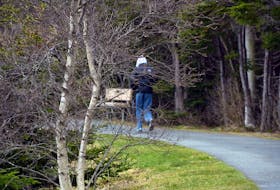ST. JOHN'S, N.L. — Juanita Mercer
The Telegram
juanita.mercer@thetelegram.com
@juanitamercer_
Gerry Byrne, minister of fisheries and land resources, says he has a plan to protect the province’s natural areas.
“I’m ready to go. This has been a priority for me,” he told The Telegram.
This comes after two members of the Wilderness and Ecological Reserves Advisory Council (WERAC) resigned because the government hasn’t released the plan it has had since 1995.
Twenty-five years ago, WERAC helped to draft the Natural Areas System Plan (NASP), a provincewide system of reserves.
Since then, it’s been repeatedly stalled due to pressure from industries such as mining and forestry, according to the resigned WERAC members and one former biologist employed by the province.
WERAC co-chair Victoria Neville and longtime member Bill Montevecchi went public with their resignations earlier this week in the hope it would push the government to take some action.
Byrne said he understands their frustration. He said the experience has been “viciously” frustrating for him, too.
“Why is it in 30 years this Natural Areas System Plan has not progressed? And so, when I became minister of fisheries and land resources and minister responsible for our protected areas, it was one of the first questions that I asked both of WERAC and the department, and stakeholders who feel very connected to all of this.
“And it was hard to get a consensus of what exactly the issue was. I think that spoke volumes.”
He said two extreme viewpoints bookend the issue.
“One is pro-development. Don’t have any protections because it may thwart or stop a particular mineral development or oil development from occurring, or forestry development.
“The other view would be protect at all costs, and protect without compromise. Protect natural areas without a reference to relative economic potential.
“And I think what has happened is that the perfect has become the enemy of the good.”
Byrne said he believes the two sides can find common ground.
He suggested “adding opinions and voices to allow the committee to really work through what are some of the decisions that can be made that are acceptable to both (sides).”
While Byrne said there have been times that WERAC and industry groups, such as mining and forestry, have been at the same table in discussions, he said “it doesn’t happen at the WERAC table formally itself.”
Byrne said the reason a NASP has been “doomed to fail” is because WERAC has not been asked to draw in the considerations of industry in its plans.
However, Byrne also said the plan has changed “literally dozens and dozens of times over” since 1995 in an effort to compromise with stakeholders, but because the changes were made “in absentia” of stakeholders, there was never any agreement.
“The mining industry has been very effective in putting its case forward that protecting areas may thwart potential exploration activity, and potential development activity.
“There has been no question that the view has been expressed by leaders within the environmental NGOs, and the environmental community, that compromise is bad, that it’s unprincipled.
“I have taken the view that there is principle in compromise when you do not surrender the core value of protecting scientifically assessed and established representative ecosystems, and choosing those areas with a lens of examining potential economic impacts as well.”
He wouldn’t give details, but Byrne said he has a “tough” plan that will simultaneously protect representative ecosystems while allowing for economic development.
“I got a feeling that plan will probably be not necessarily appreciated or applauded by either side of this great debate, and maybe then that might be the greatest indicator of my success.”
Byrne said he is ready to present the plan to cabinet, which would debate and potentially give authorization to present it to the public. He said the plan he will present includes advice from WERAC.
Byrne wouldn’t provide a timeline for when he will bring the plan to cabinet, saying only that “there’s a process.”









